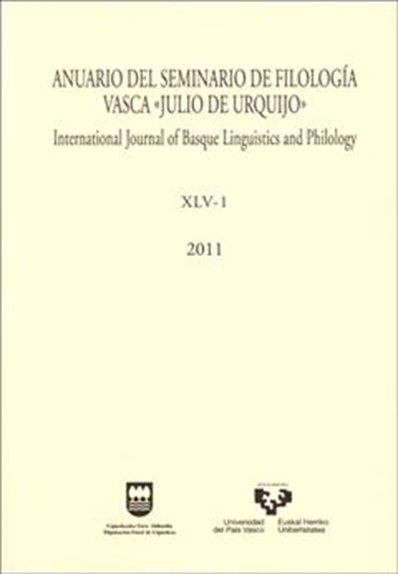Euskal metatesiak: abiaburua haien ikerketarako
##plugins.themes.bootstrap3.article.main##
##plugins.themes.bootstrap3.article.sidebar##
Published
06-06-2011
Ander Egurtzegi
Abstract
The typological classification of metathesis, which is usually best understood as any reordering of segments or features within the phonological string, has experimented a great step forward in terms of analysis and understanding of the phenomenon as a consequence of the work of Blevins & Garrett (1998, 2004). Following their model, I have analyzed the different metathesis processes found historically within the Basque language and identified the underlying motivation, which is phonetic in nature. The main hypothesis is that metathesis is a phonetically natural process that can be analyzed following the same assumptions made for any other phonological change.
I will distinguish two kinds of metathesis processes, the first involves a single segment being relocated in the phonological string whereas the second interchanges a pair of (different) segments. The former can only involve features bearing elongated phonetic cues (Ohala 1981), and the latter is a nonlocal two-segment transposition involving restricted pairs of vowel or consonants that are similarly produced to some extent, and that are usually located in the same position of two adjacent syllables, i.e. two vowels in the nucleus or two consonants either in onset or coda position.
This work adds new evidence taken from Basque to further develop the analysis of metathesis as a phonetically natural process that is produced by phonetic reasons, based on the common properties of any output driven process (Ohala 1981, 1993), along with articulatory reasons such as motor planning errors (Garrett & Johnson).
I will distinguish two kinds of metathesis processes, the first involves a single segment being relocated in the phonological string whereas the second interchanges a pair of (different) segments. The former can only involve features bearing elongated phonetic cues (Ohala 1981), and the latter is a nonlocal two-segment transposition involving restricted pairs of vowel or consonants that are similarly produced to some extent, and that are usually located in the same position of two adjacent syllables, i.e. two vowels in the nucleus or two consonants either in onset or coda position.
This work adds new evidence taken from Basque to further develop the analysis of metathesis as a phonetically natural process that is produced by phonetic reasons, based on the common properties of any output driven process (Ohala 1981, 1993), along with articulatory reasons such as motor planning errors (Garrett & Johnson).
How to Cite
Egurtzegi, Ander. 2011. “Euskal Metatesiak: Abiaburua Haien Ikerketarako”. Anuario Del Seminario De Filología Vasca "Julio De Urquijo" 45 (1):1-79. https://doi.org/10.1387/asju.9725.
##plugins.themes.bootstrap3.article.details##
Issue
Section
Articles
This works is licensed under a Creative Commons Attribution-NonCommercial-NoDerivatives 4.0 International License.


